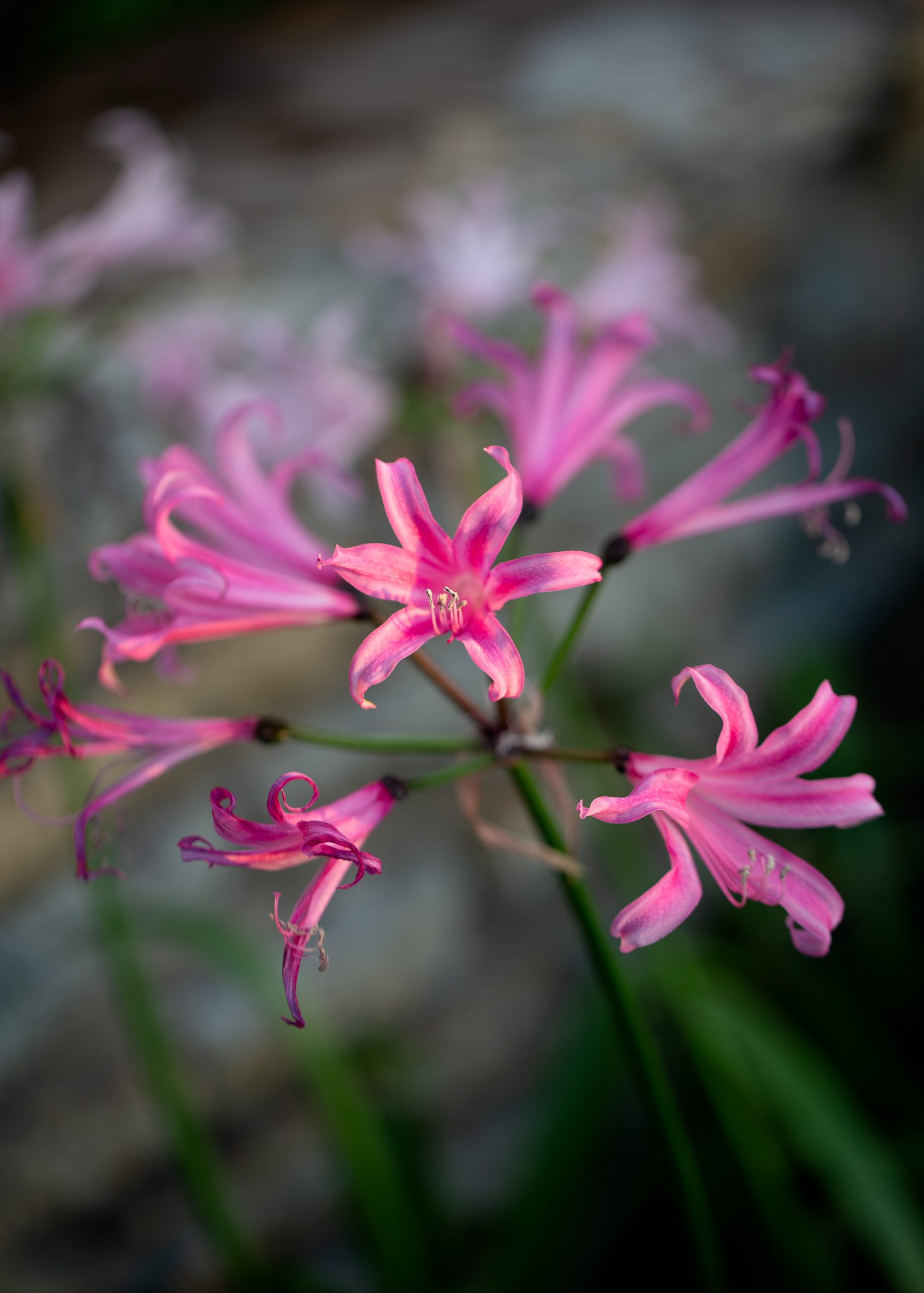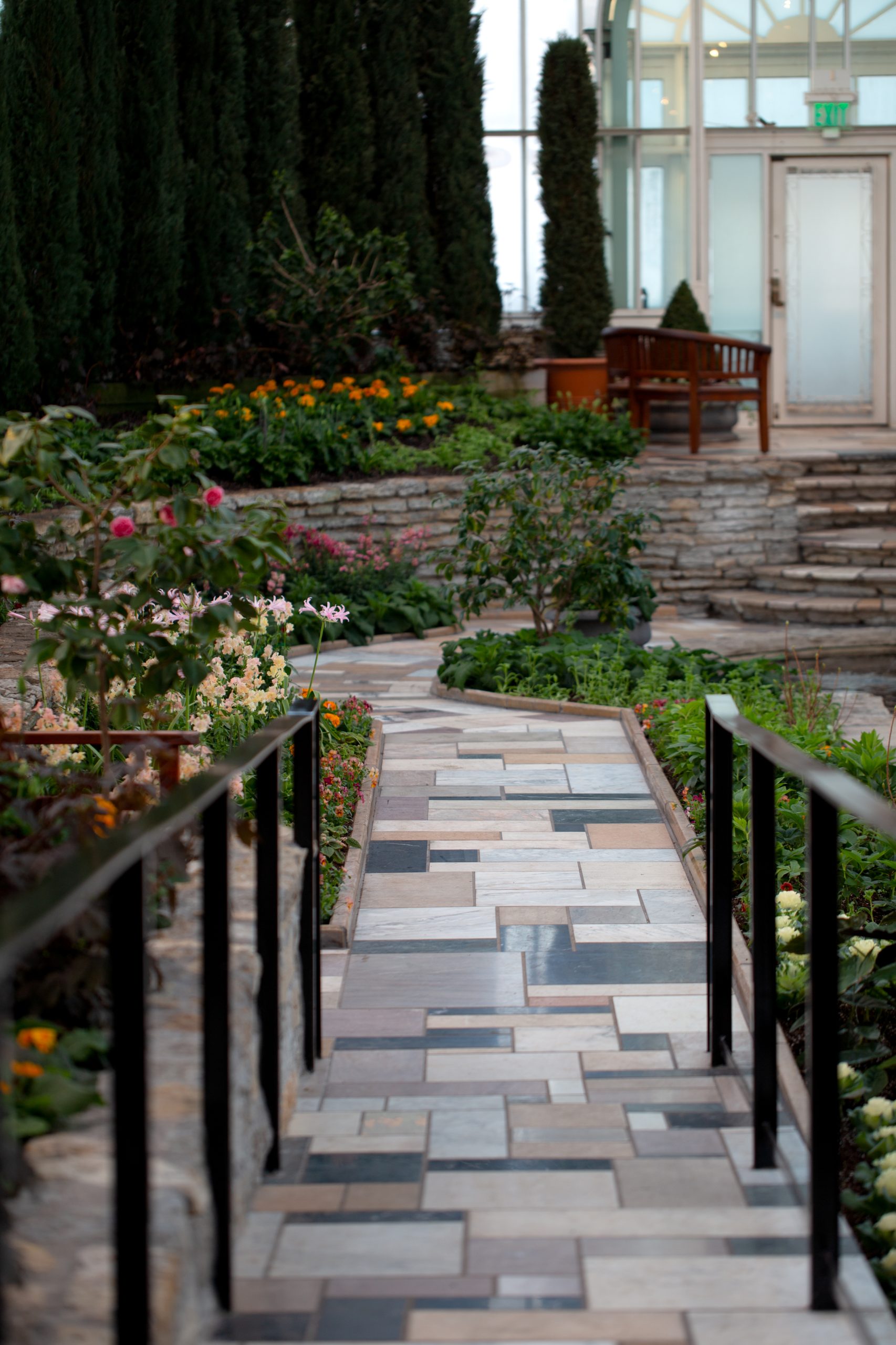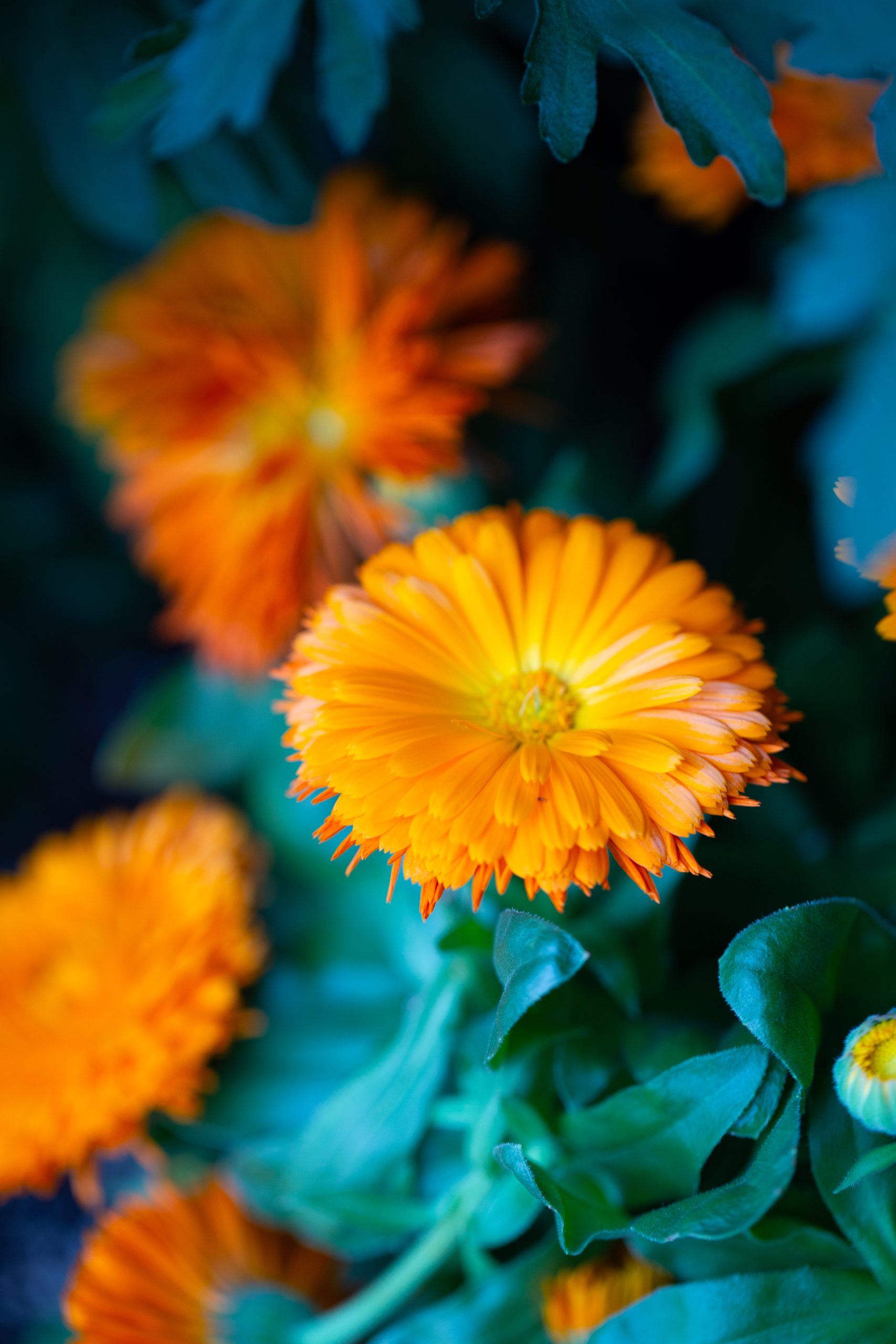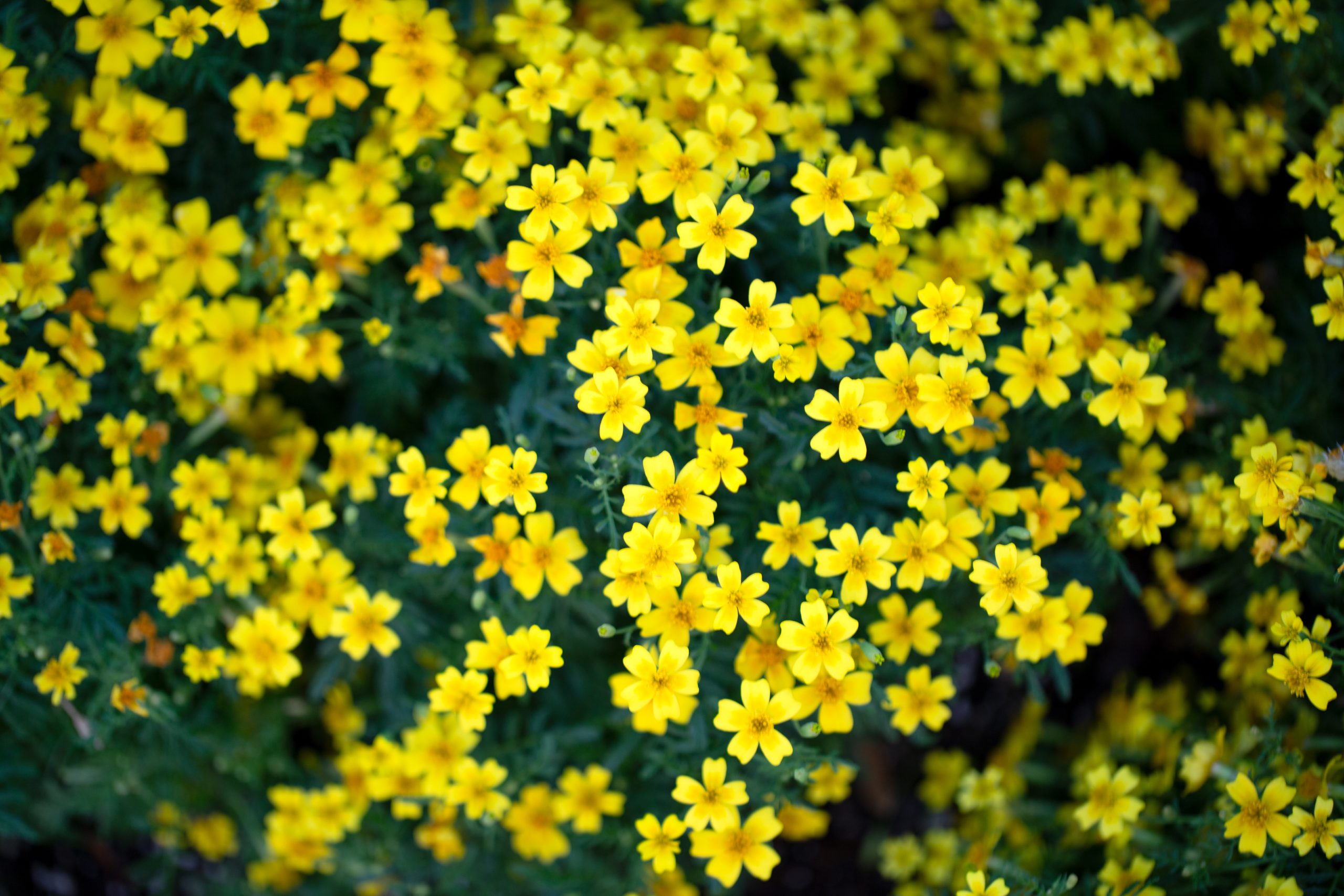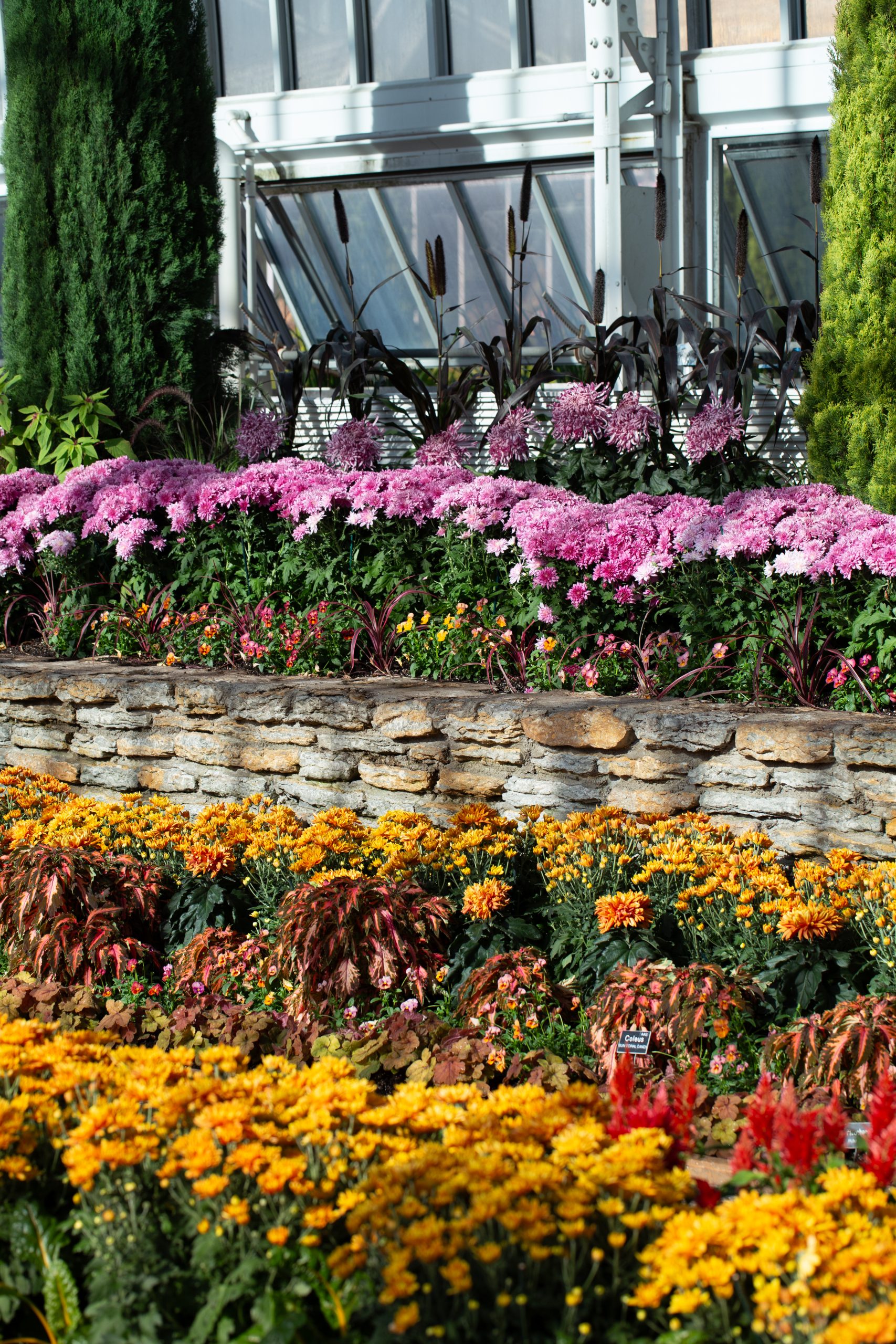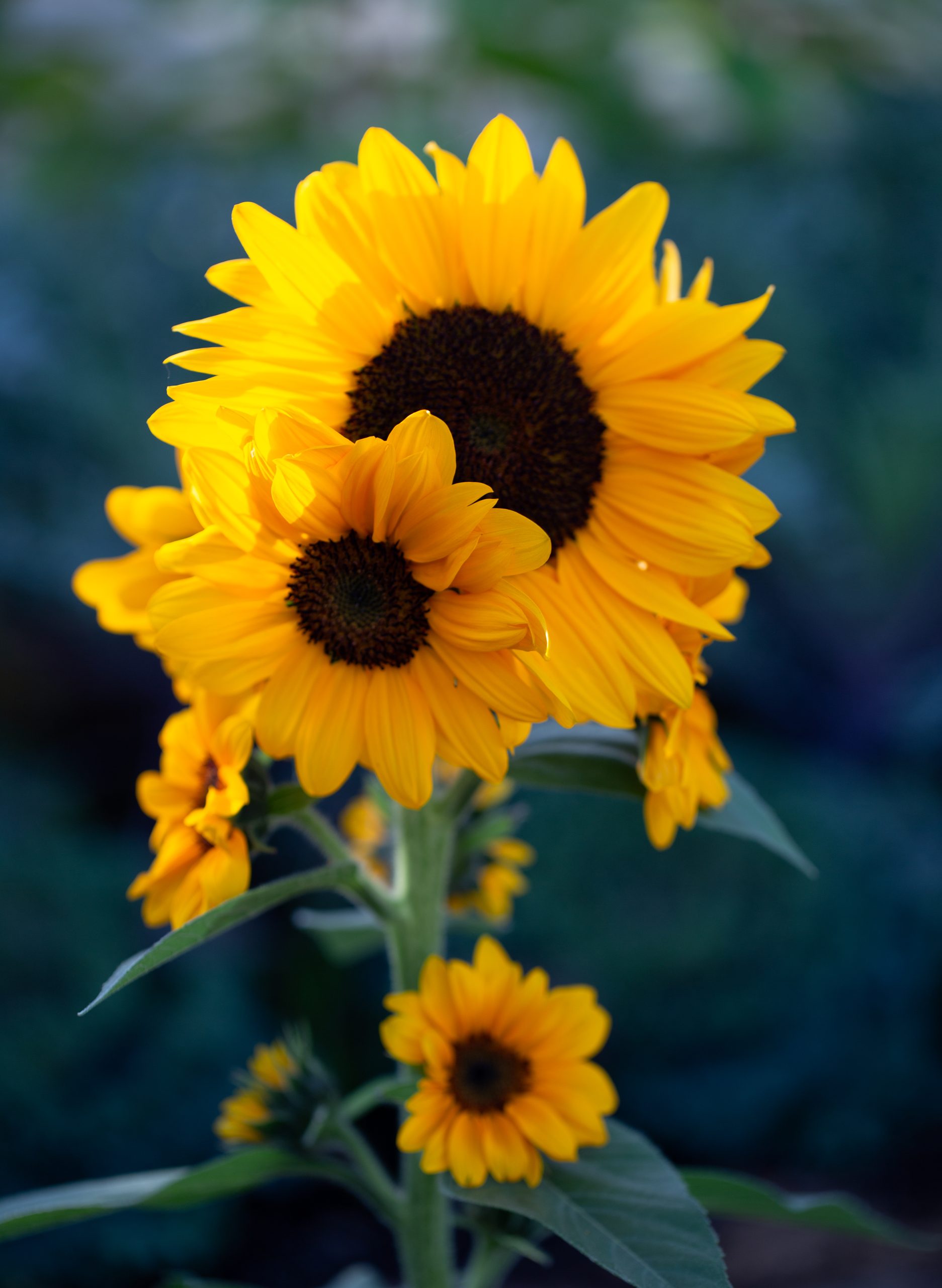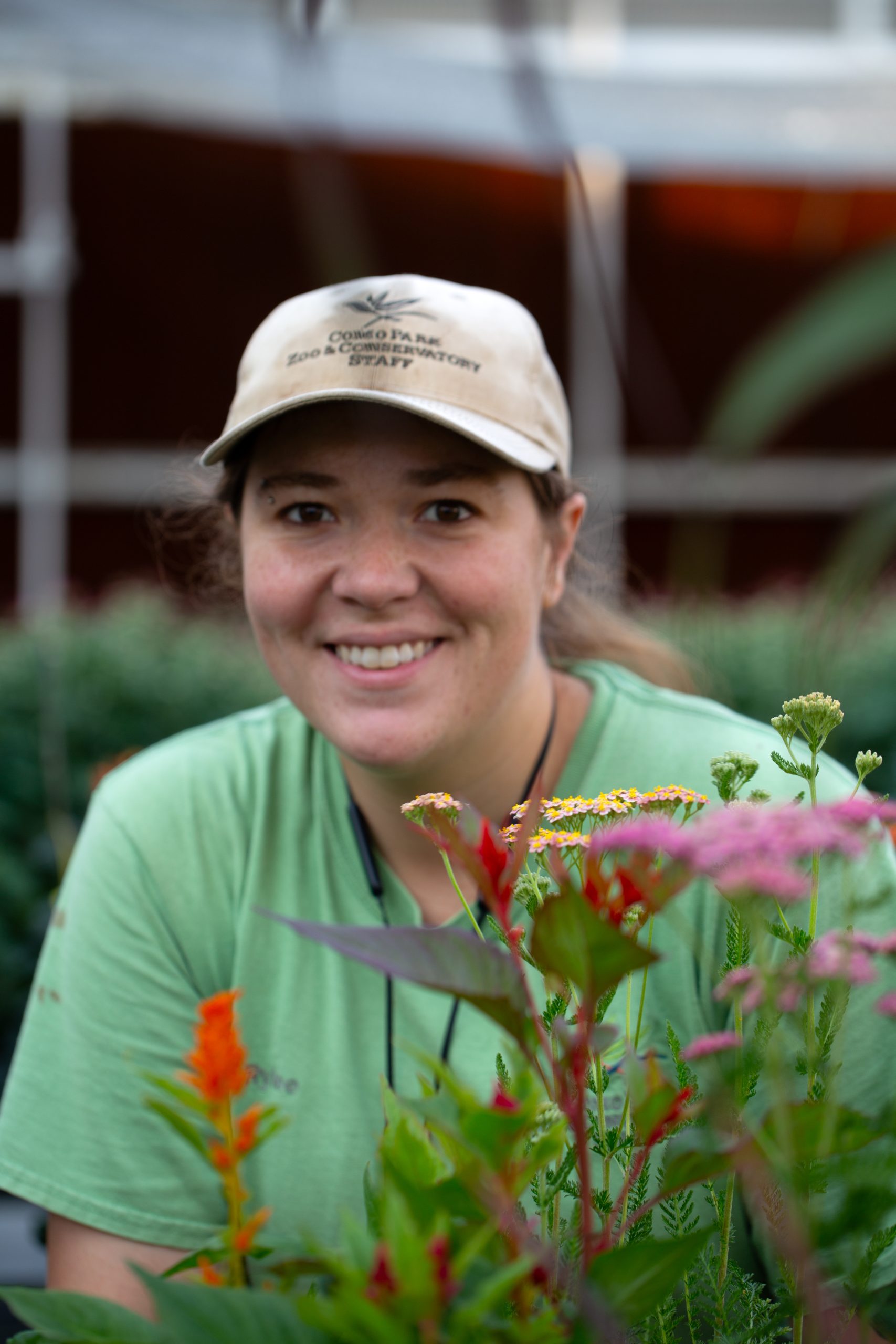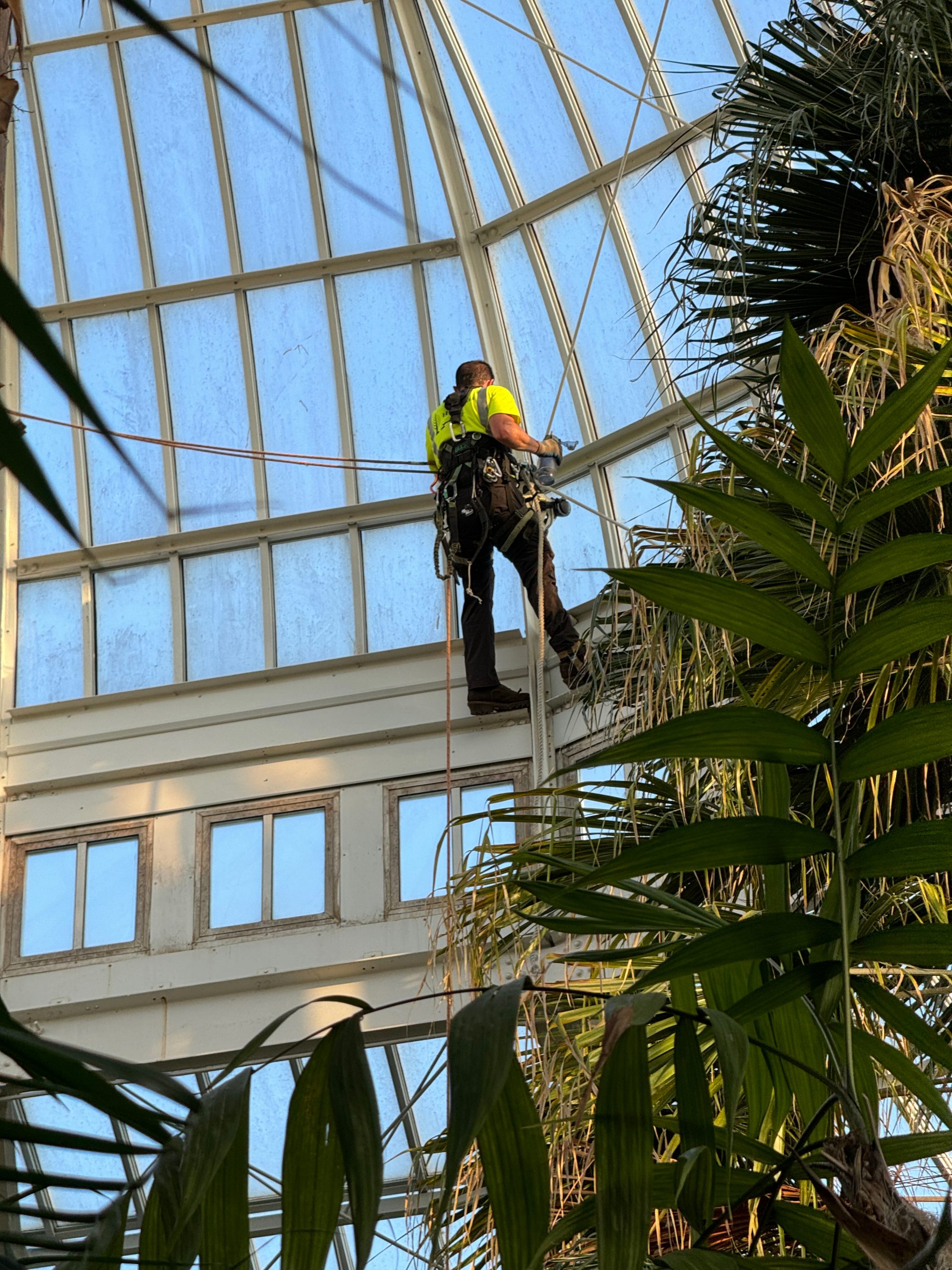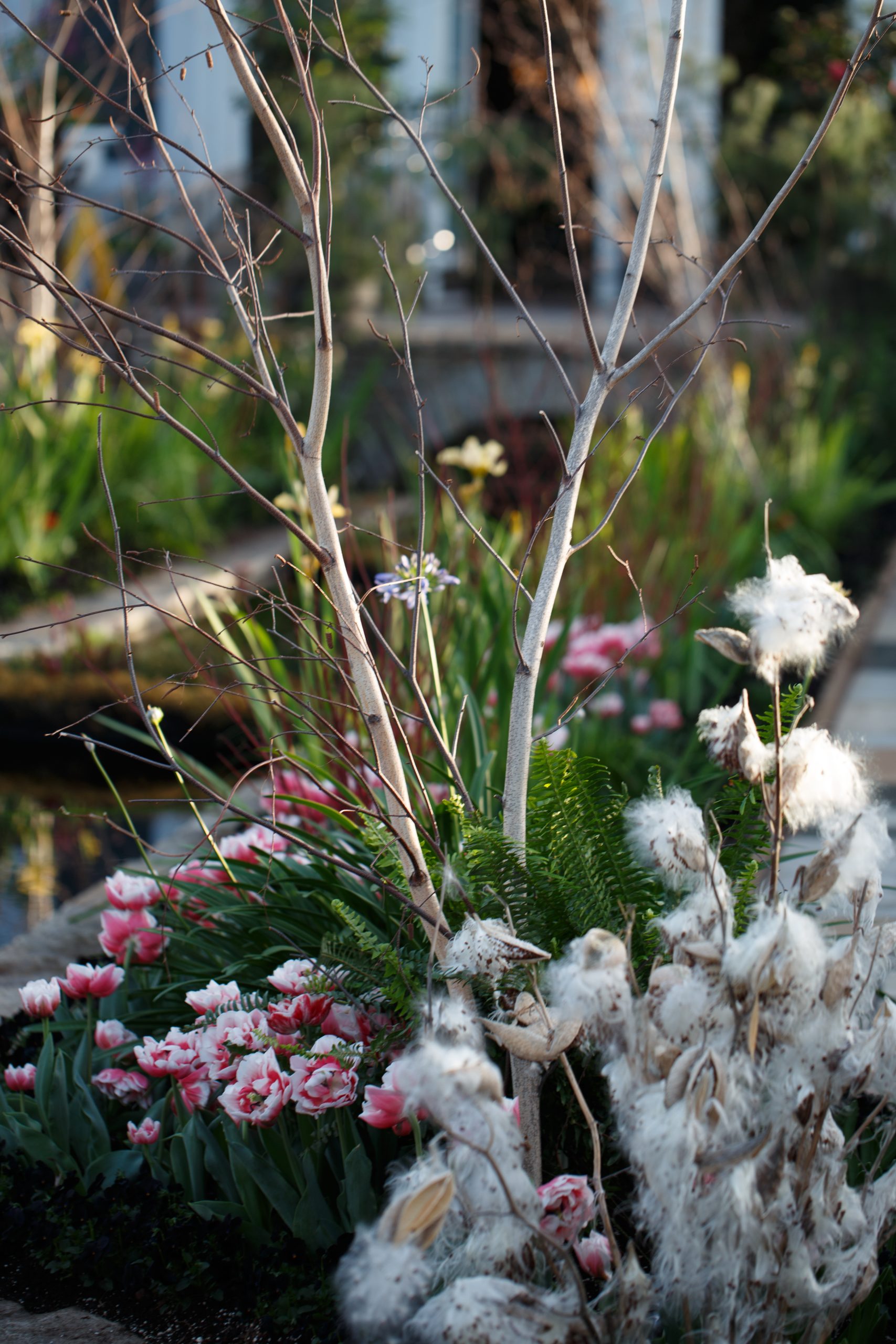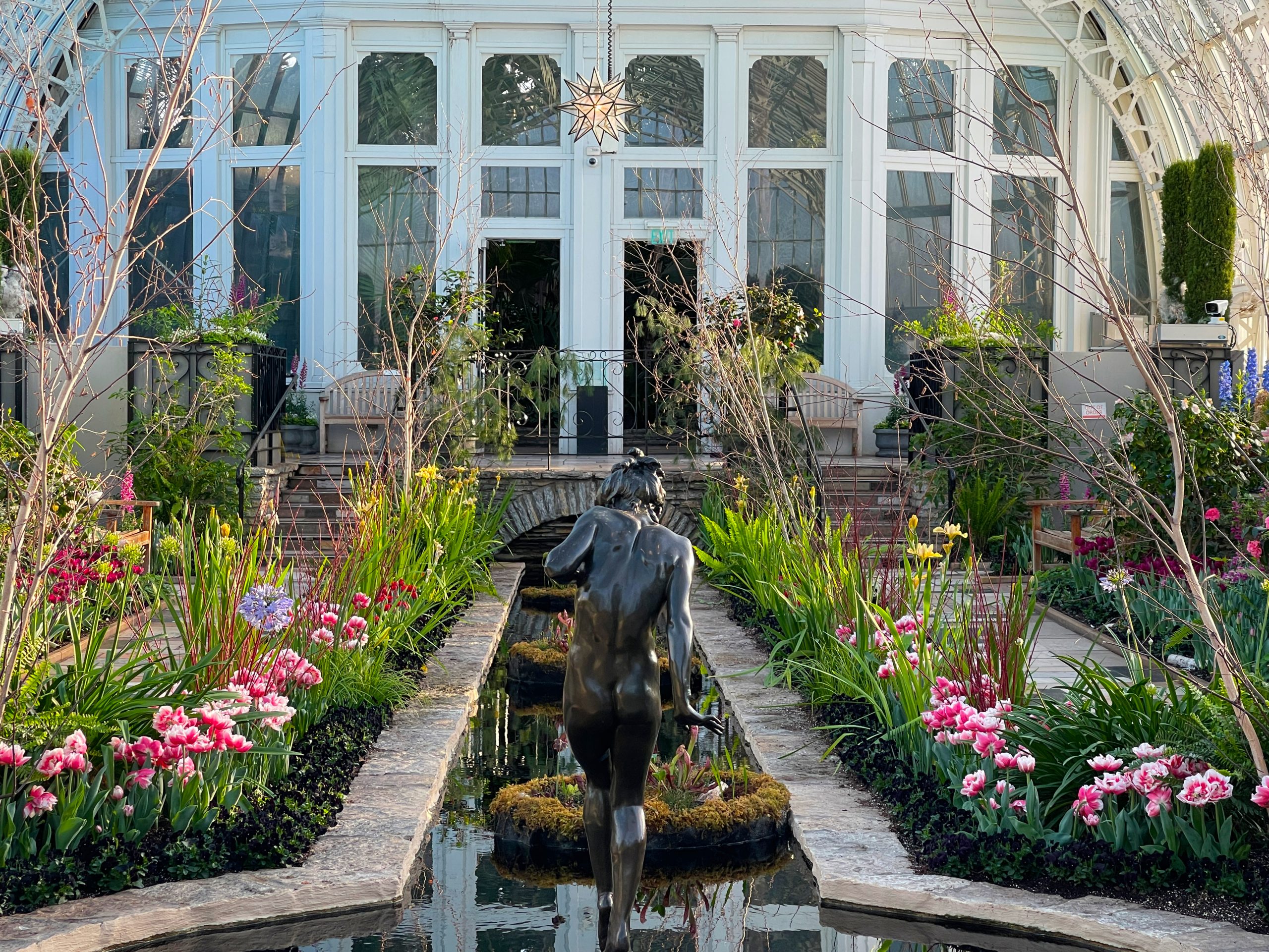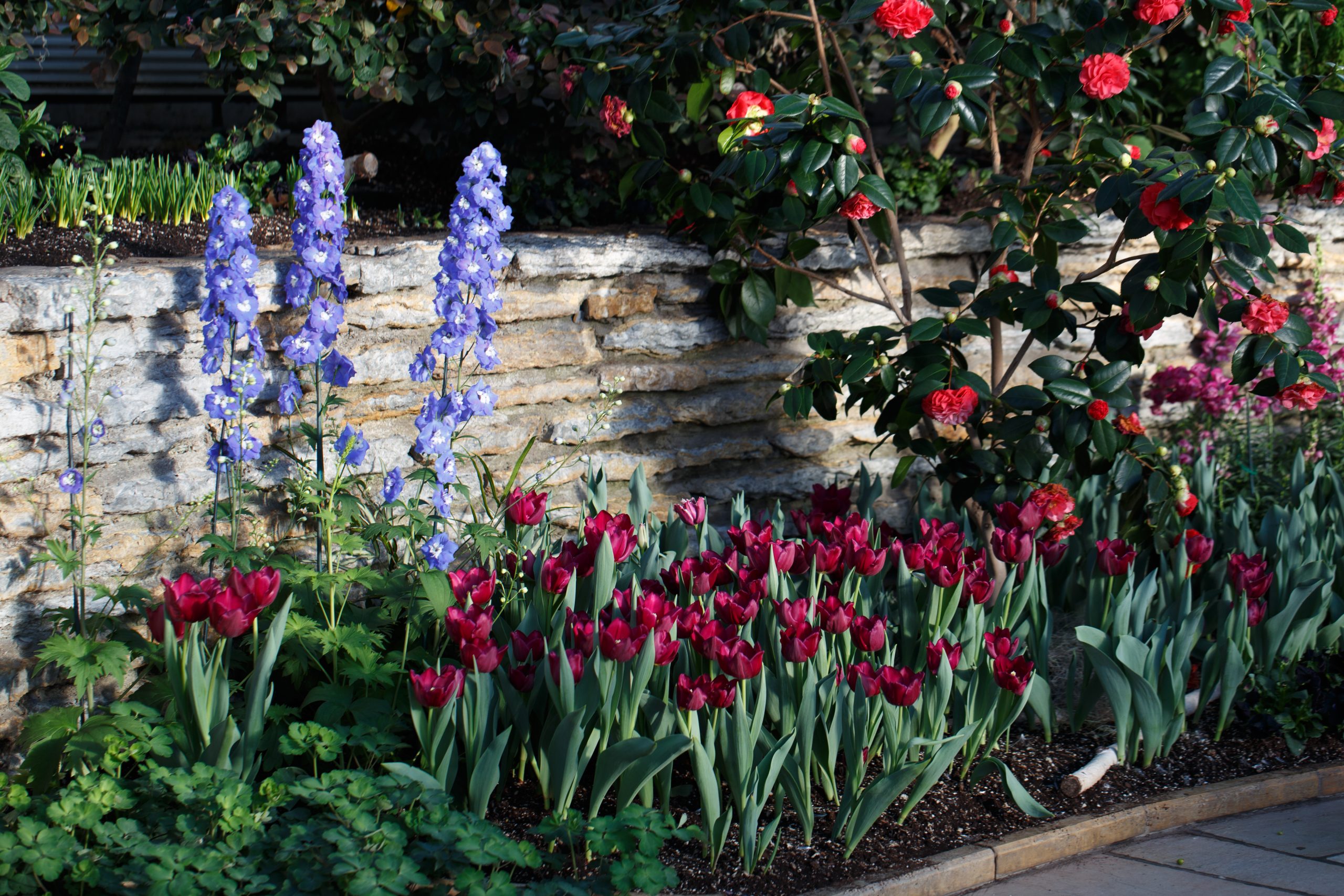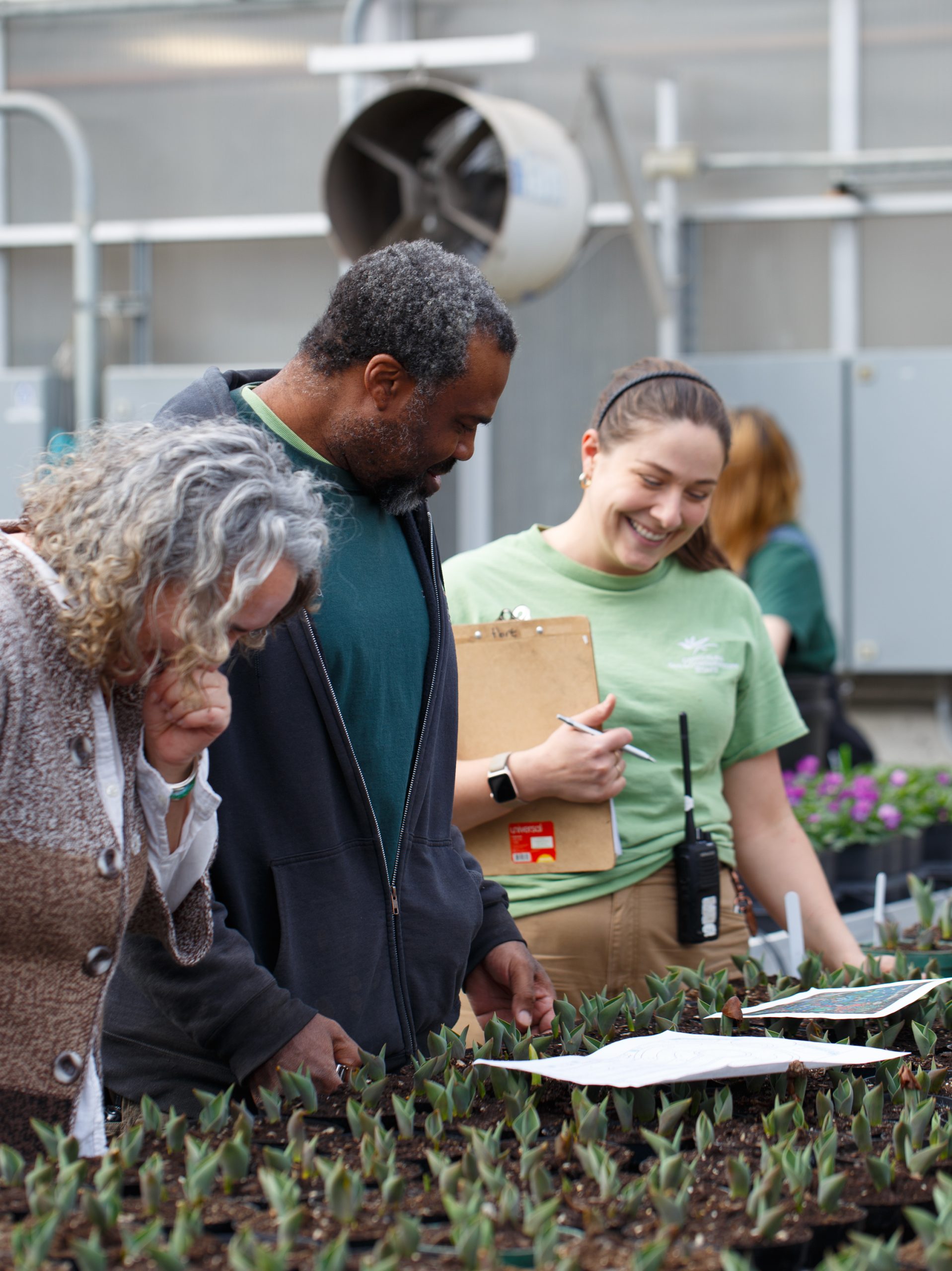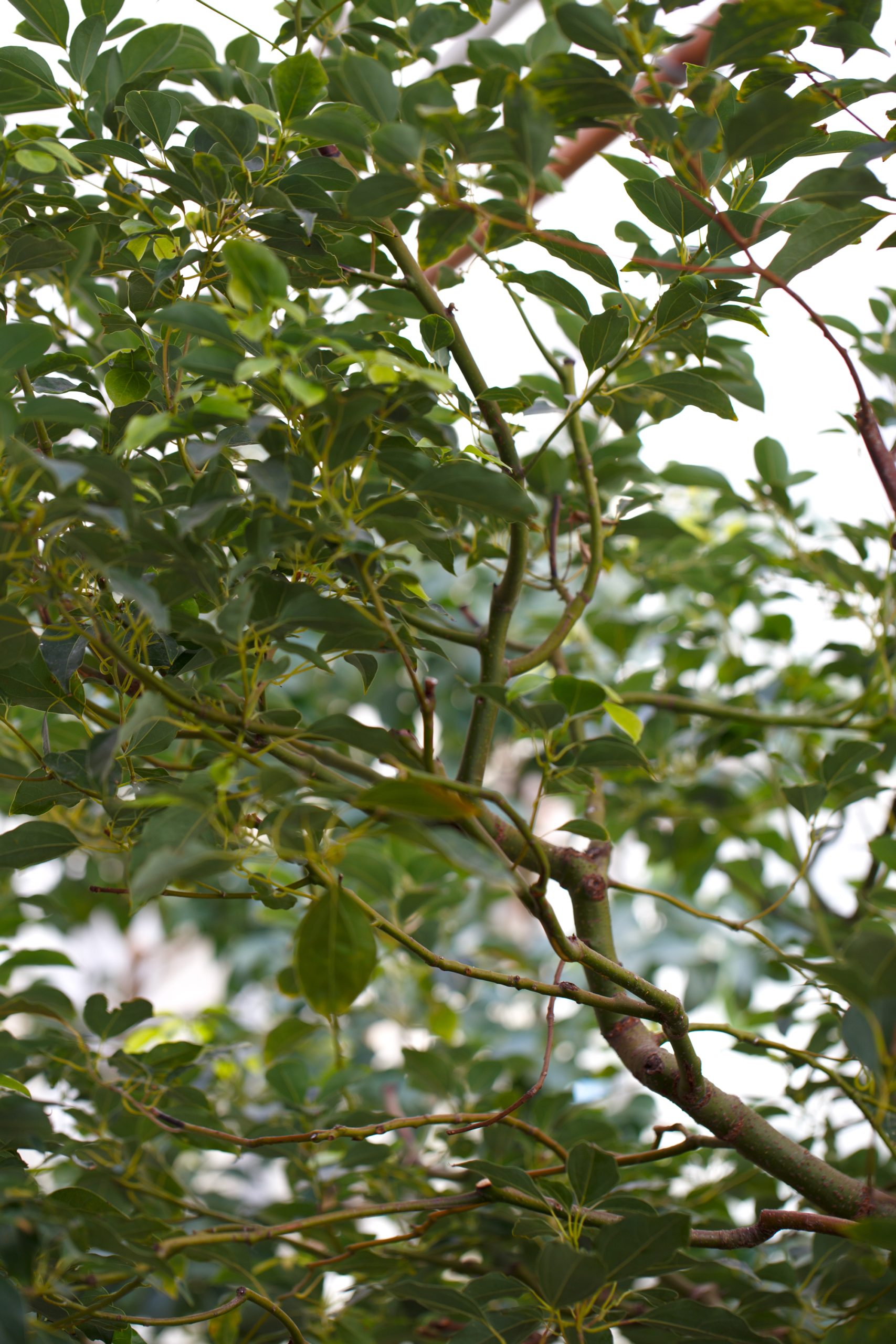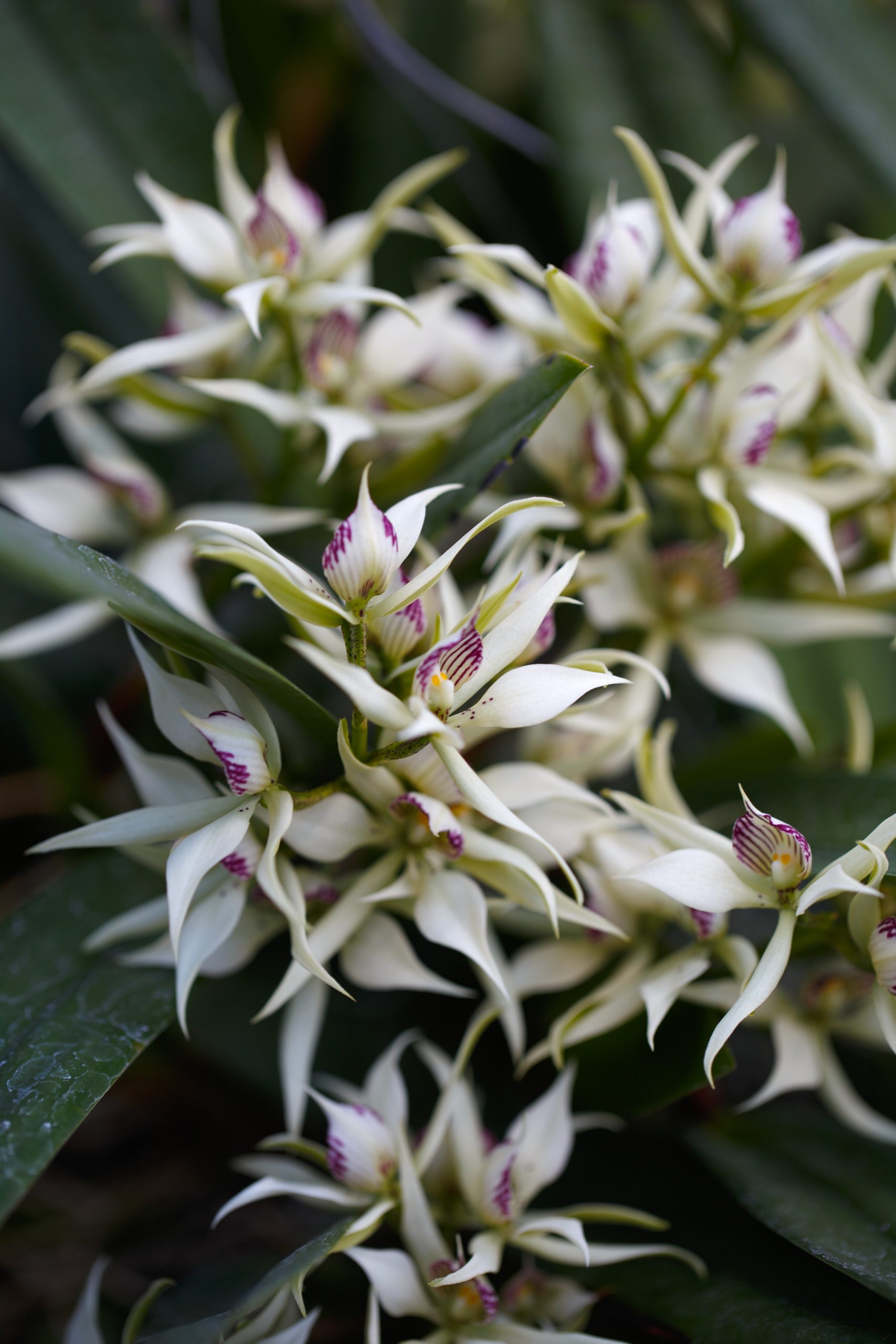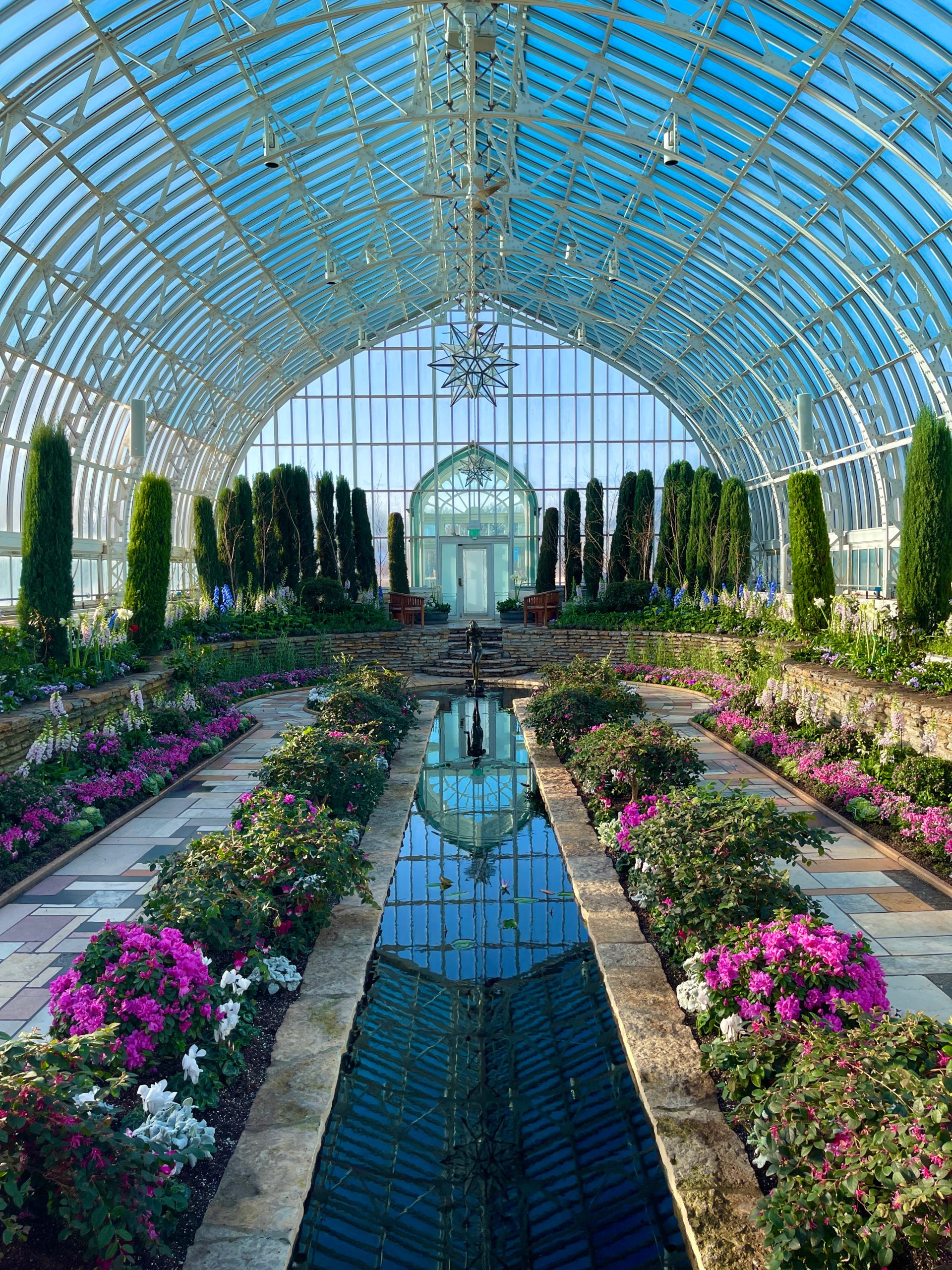As the 2025 Winter Flower Show at the Marjorie McNeely Conservatory opens this week, many visitors will enjoy their first glimpse of the new accessibility improvements recently made to the Sunken Garden. Knowing that so many eyes would be on the space after its two-month closure, horticulturist Katie Horvath decided to create a floral design scheme that would give visitors a very warm welcome back.


“Winter can be a time for those cooler, icier colors, which are beautiful, but when I got to thinking about what I like best in winter, it’s about finding those warm, cozy spaces,” says Horvath. “Walking in to find warmth in the middle of winter became my goal for the garden’s design.”
This is Horvath’s first design for the Sunken Garden, a process she started more than a year ago to guarantee that featured flowers like the primrose would have the time required to start from seed and go through a lengthy cold-weather germination process. She also spent time exploring more tropical color tones than are typical in wintery botanical gardens. “I looked at ways of combining a lot of oranges and yellows and peachy sherbet-type colors, with mixtures of cherry and caramel and a lot of really pretty deep reds.”
Among the standouts are the hibiscus mahogany splendor, a peachy dalmatian foxglove, and a mix of buttery and dainty chantilly salmon snapdragons, and pilea Moon Valley with its distinctive kiwi- and bronze-colored leaves. Como’s production greenhouse also cultivated the charming sweet pea vines climbing up the trellises installed throughout the garden.
The other star of the show will likely be the new pedestrian ramps that now lead to the garden, improving access for guests with strollers, walkers, wheelchairs and other mobility challenges. “Change isn’t always easy,” Horvath says about the nearly 100 years of memories contained in Minnesota’s most beautiful room. “But hopefully when people get back into the Sunken Garden they’ll appreciate how amazing the space is, and just how amazing plants are.”
Thanks to your contributions to Como Friends, Como’s five seasonal flower shows are always free to visitors. The Winter Flower Show is open daily from 10 a.m. to 4 p.m. through March 16, 2025.

“I really do feel the weight of how important it is for this space to reopen. I’m excited and incredibly proud to have grown these flowers and plants, designed the show, and finally planted the mixed beds again. But I also recognize how challenging it is, so I do feel a bit nervous about that. At the same time, I just think plants and flowers are incredible. When people walk into the Sunken Garden and see everything we’ve been cultivating, I hope they’ll appreciate it for more than just the structural changes in the space. I know this will be a big deal for some people—change can be tough, and there are a lot of changes in there. The space is going to feel new and different, and while the ramps and other elements may not be what some are used to, I’m hopeful that the beautiful plants and flowers surrounding them will make those changes feel easier to embrace.”

Making Minnesota’s most beautiful room more accessible for the future

For one of the first times in its century-long history of service, the Marjorie McNeely Conservatory’s Sunken Garden closed to the public earlier this winter to allow for the construction of two pedestrian ramps that will make the space more accessible to visitors. The brief closure also gave Como the chance to give the wing—a favorite Twin Cities wedding destination—a little extra sparkle. As the new and improved space reopens to the public this season, here’s a look at some of the features that make the Sunken Garden so special to so many.


1). While the flowers come and go in the Sunken Garden, Minnesota’s most beautiful room has very deep roots. Originally opened as the Marjorie McNeely Conservatory’s south wing in 1915, the room was remodeled about a decade later to create the features we recognize today—the long, narrow floral beds, the lengthy reflecting pool, and the exceptional view from above that allows visitors to take it all in. “Sunken gardens were a trend in Europe at the time,” says Paul Knuth, the retired horticulturist who created the room’s rotating flower shows for more than 30 years. “But I think being able to see everything from one spot would have been the real inspiration. That view is easy on the eyes.”
2). A beautiful example of the Victorian glasshouse movement, the Conservatory’s listing on the National Register of Historic Places requires renovations to stay within the framework of the building’s original design, including recreating the distinctive marble flooring pattern on the new ramps. With masonry work that’s been kicking up a lot of dust, crews are also planning a deep cleaning of the windows and these Moravian star pendant lights. A traditional shape made popular in Germany in the 1830s, the star pendants were created by German immigrant and St. Paul craftsman Harry Fritsche. According to his grandson, Fritsche made and donated the now iconic lights to the Conservatory “as a gift to the city that welcomed him during difficult times,” and they have been hanging over the Sunken Garden since 1935.
3). “Play Days,” the beloved bronze sculpture at the south end of the Sunken Garden was also removed from the Sunken Garden this winter for repair and renovation. Created by Harriet Frishmuth, an American artist who studied with Auguste Rodin at Paris’s École des Beaux-Arts, the iconic sculpture is actually one of 99 known castings made of the work. In a fun twist of Como coincidence, this piece was donated to St. Paul in the 1960s by senior horticulturist Ariel Dressler’s godparents. “So many people feel a family connection to that room, and so do I, when I’m dusting that statue,” she says.
4). The Sunken Garden is a flower powerhouse, accounting for more than a third of the plants, plugs and bulbs grown each year in Como’s behind-the-scenes greenhouse. That number may even grow with the removal of the obsolete elevators, which has created more room for flower beds. “That’s something we’re excited about, because it’s a pretty significant new space for planting,” says Dressler. The spring and summer flower shows alone typically require up to 10,000 bulbs each year, which means that more than a million tulips, hyacinths, daffodils and other varieties have cycled through the Sunken Garden over the last century. “For years, Como Friends has offered the bulbs for sale when we’re finished with them, so it’s fun to run the numbers and imagine all of the decades that Como’s gardens have been making the community more beautiful, too,” says Dressler.
The Sunken Garden is also the site for Como’s Music Under Glass series this winter, a free concert series featuring local artists on selected Wednesday and Sunday nights. Visit comozooconservatory.org to learn more.

Como Brings Conservation to Life
From the first breaths taken by Como Zoo’s new tiger cubs, to the tender care that’s giving extra years to elder animal ambassadors like Nan the polar bear, Como Park Zoo and Conservatory is on a mission to bring the value of conservation to life in every season.
On Give to the Max Day, your generosity helps bring conservation to the forefront every day at Minnesota’s most visited cultural destination. From crucial breeding programs to preserve our planet’s most endangered animals, to sustainable habitats that tell deeper stories about the Earth’s diversity, your support helps Como Park Zoo and Conservatory welcome the next generation to discover the wonders of nature through unforgettable face-to-face encounters, fantastic education programs, and always-free admission.
And thanks to a matching gift from the Como Friends Board of Directors and a generous donor, your gift will be doubled, dollar for dollar, up to $53,200.

This year, Give to the Max Day supporters helped choose the name of Como Zoo’s new baby nyala, born in September, by picking their favorite—Harvey, Stanford, or Walter. The winning name with the most votes is Walter!

The final Flower Show of the year celebrates the warmth of autumn



Right Track apprentice Willow Stephens grew up coming to Como, where the Sunken Garden once played host to a family wedding. This season’s show features her favorite flower—celosias “pampas plume”—as a supporting player.
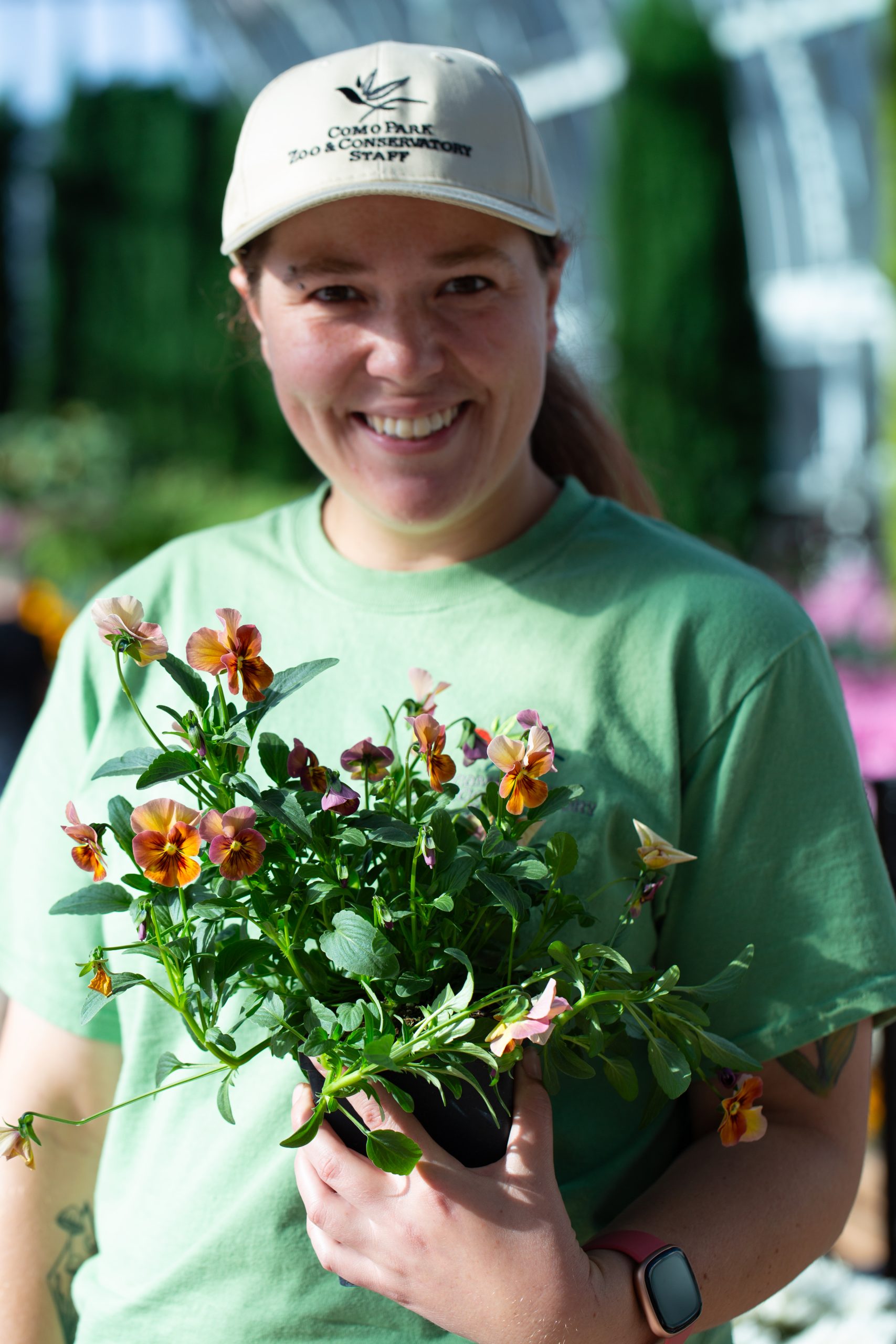
A long-running design trend in fashion, hair, and homewares, the ombre pattern is now making its horticultural debut in the Sunken Garden, where waves of yellow, gold, pink, and purple chrysanthemums ripple against the room’s reflecting pool.
“The theme we were going for was ‘sunset on the water,’” says Willow Stephens, the Right Track horticultural apprentice who co-designed the show along with Como horticulturist Rylee Werden. “The white mums at the end of the pool represent the bright sun, and then you see the colors around it fade away, yellow to orange, pink to purple.”
And now through November 16, Como’s Fall Flower Show is taking its inspiration from the color palette of Como Zoo’s lions, Mumford and Maji. Sunken Garden flower shows are free to the public, and made possible, in part, by your support for Como Friends. Thank you!
An autumn tradition for more than a century, designing the Fall Flower Show at the Marjorie McNeely Conservatory is a cool project for any young horticulturist to have on their resume. But this season’s display is extra special—it will be the last shot of color in the Sunken Garden before it closes for renovations that will make the historic room more accessible to visitors with strollers, wheelchairs, and other mobility challenges. While it’s under construction, Como’s horticulturists, and an event and display company are planning a poinsettia display for the Visitor Center porch.
“There’s never a great time to close any corner of Como, particularly a garden that visitors love as much as the Sunken Garden,” says Como Campus Director Michelle Furrer. “While we won’t be able to experience the Holiday Flower Show, we are planning a special exhibition, Winter’s Blooming Wonderland, that includes the traditional poinsettias on the Visitor Center Porch.”

That’s why horticulturists came up with a particularly colorful plan for this season’s two-part flower show. Following the sunset theme, which runs through October 27, the second half takes its inspiration from the color palette of Como Zoo’s lions, Mumford and Maji, and will run from November 1 through 16.
In addition to traditional mums, Werden says visitors will see her favorite plant, the viola “antique shades,” and many other vibrant supporting players. “The cooler temperatures and shorter days do restrict the types of plants that we can select, but we’ve chosen some that give the room a nice fall feel—chard and kale, marigolds, millet, and grasses all look great with these mums.”
“We’re really excited about having a room that’s more accessible, and that more people can appreciate,” says Werden. “And one thing we really like is that these changes will even create a little more space for garden beds.”
Symbolizing joy, luck, friendship, and rebirth, chrysanthemums have been the centerpiece of the Marjorie McNeely Conservatory’s fall flower shows since 1915. This year’s show highlights the versatility of mums by featuring the same plant side by side—one in the traditional shape, the other pruned back to create a show-stopping central bloom.

To keep all of these plants healthy, Werden recently released hundreds of lacewings into the Sunken Garden. These tiny but mighty beneficial bugs can help protect chrysanthemums from pests known as “thrips,” and the potentially deadly viruses they carry. The Integrated Pest Management program was funded in 2024 by your support to Como Friends. Thank you!



Watch your inbox for a Como Friends’ invitation to a special donor preview of Winter’s Blooming Wonderland, which will be on display in Como’s Visitor Center porch in December. Sign up here.
Fall Sunken Flower Show plant list: Celosia, Yarrow, Viola, Kale, Marigold, Swiss Chard, Dusty Miller, Coleus, Black Eyed Susan, Millet, Aster, Amaranth, a variety of Sunflowers, Ornamental Peppers and Kale, and Pennisetum
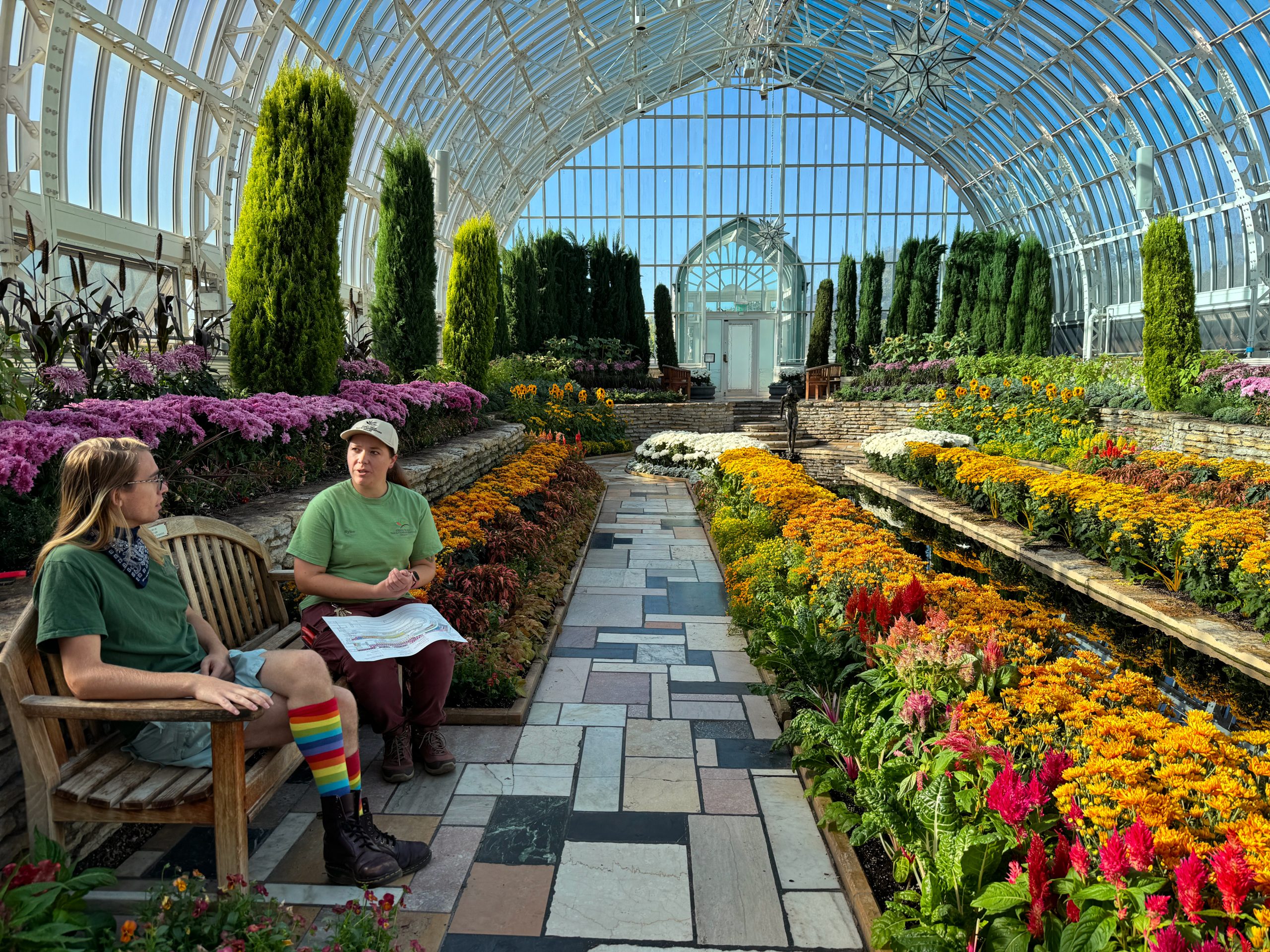

In the Marjorie McNeely Conservatory we bid a fond farewell to the Summer Flower Show ending on September 22, and a warm welcome to the Fall Flower Show opening on September 27


The annual shift from warm summer sunshine to crisp autumn glow seems to happen overnight, but at the Marjorie McNeely Conservatory, this seasonal change takes months of careful planning. As Como’s Summer Flower Show fades on September 22, and the Fall Flower Show comes into bloom on September 27, check out this pictorial preview of the behind-the-scenes prep work that helps Minnesota’s most beautiful room make a change of season.
Horticulturist Rylee Werden and RightTrack Apprentice Willow are collaborating to bring their vision of an autumn sunset to life in Minnesota’s most beautiful room. “Other than the mums of course, we are planning to feature a variety of fall plants in sunset colors including yarrow, celosia, ornamental peppers, chard, violas, heuchera, kales, sunflowers, marigolds, millet and grass,” says Werden.
A first-time show for Willow, who has been working closely with the entire horticulture team for more than a year now. “It’s been great to hear Willow’s ideas and incorporate my vision and hers together,” says Werden. “We are really excited to see everyone’s reaction to our ombre color scheme from around the pool to try to mimic our inspiration of a sunset on the water.” Here’s a sneak peek.


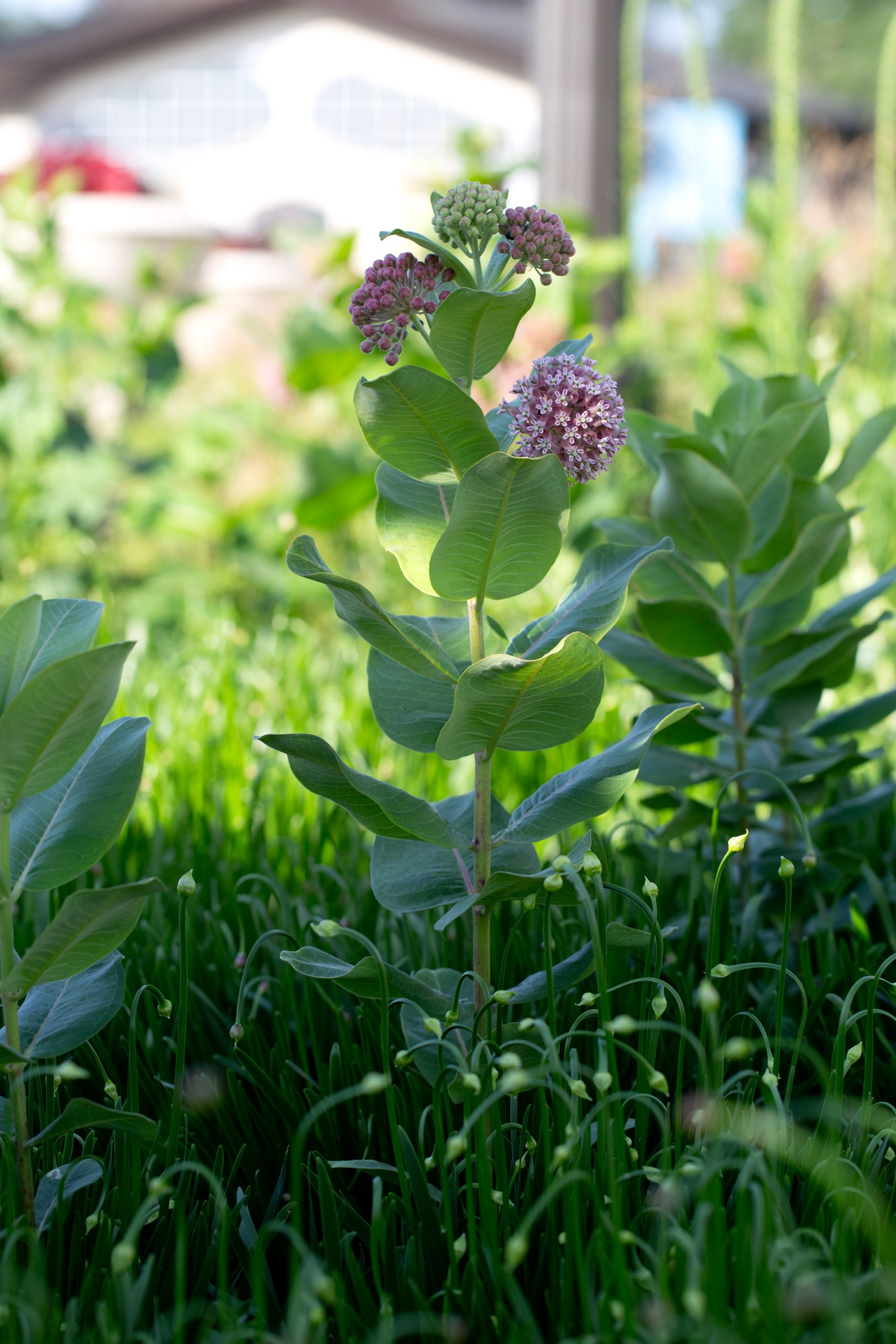
With support from Como Friends, horticulturists at the Marjorie McNeely Conservatory are designing a more sustainable gardening plan for Como’s exterior spaces



Making Como’s extensive exterior gardens look good is hard work, but Marjorie McNeely Conservatory horticulturist Marie Day gets lots of encouragement to keep at it.
“One of my favorite things about this job is just how much positive feedback you get from the public,” she says. “I can be out there, working in a garden, maybe even feeling stressed out that something isn’t looking the way I want it to, and then I’ll have 10 people walk by telling me how beautiful it is. I don’t think that’s something most people get to experience in their jobs, and it really lifts you up and makes you feel you’re doing something that matters.”
Day’s latest horticultural project is Gates Ajar, the traditional mosaiculture feature Como gardeners have created for more than a century. Located across Lexington Parkway near Como Lake, this year’s design features Minnesota’s new state flag and seal rendered in a mix of colorful alternanthera and echeveria, a fast-growing succulent. Installing this year’s display of more than 5,000 annuals and 300 bedding plants required more than 100 gardener hours, while maintaining it typically requires 45 minutes or more of watering every day. “It’s a big project and an important tradition,” says Day. “Every year, our goal is to make it a little more creative, and a little more surprising.”
Another project visitors may notice this season is a shift toward more perennials and native plants in garden beds around Como’s campus, as horticulturists replace more traditional tropical annuals. For instance, the Minnesota Garden that greets visitors at Como’s front door will be even more Minnesotan this season with the phased planting of a host of new native plants like rattlesnake master, prairie dropseed, false indigo and prairie alumroot.
“There are two big reasons for making this shift,” says Day. “One is that we just have a really huge amount of garden space to take care of, and having those perennials established means that we’ll have more time to bring a higher standard of care to all of our exterior gardens.
“The other reason is, as we think about climate change, having areas that are filled with nothing but tropical plants that need a lot of tending is just not sustainable,” she says.
“Perennials are more drought tolerant, more tolerant to heat, and are also really good for pollinators.”


Visitors to the Marjorie McNeely Conservatory’s historic Palm Dome may notice something different this season—a lot more sunlight.

The brighter feel of the room is the result of an extensive pruning project to remove several older palms that had grown so tall they were crowding into the glass cupola. Unlike species that can be trimmed to grow outward, “the growing point of a palm is at the top of the plant, so the pressure of pushing into the glass would eventually kill the plant,” explains Karen Kleber Diggs, horticultural supervisor.
The strength of these tropical palms can also put the Conservatory’s historic dome at risk.
“A couple of years ago, we had one of the palms on the side actually grow up with a very stiff frond that punched its way into the grout” between the cupola’s glass panes, she says. “These are very powerful plants.”
Typically, the Marjorie McNeely Conservatory works with the city’s forestry department to provide pruning help, but with the spread of emerald ash borer, trimming Como’s tropical trees wasn’t possible this year. That’s where Como Friends stepped in, providing $70,000 in grant funding to help Como’s campus move ahead with tree maintenance in the Palm Dome, the North Garden and a few other locations around campus.
“Grants like this are one of the important ways that Como Friends helps the Marjorie McNeely Conservatory achieve its mission,” says Jackie Sticha, president of Como Friends. “If city funding or park resources are pulled in different directions, community support helps to ensure that Como can move ahead on urgent or emerging maintenance issues.”
New palms—also provided with funding from Como Friends—will take their place as part of a phased succession plan visitors will see in the coming months. While gardeners are always sorry to see 20-year-old palms go away, the extra space has allowed horticulturist Alejandro Balderas to redesign the understory of the palm room. “He’s been utilizing a lot of our bromeliad and orchid collection to create these colorful accent points he calls vignettes that bring a new focal point to the ground cover space,” says Kleber Diggs. “He’s seeing things in that room with fresh eyes, which is something our visitors may notice this season, too.”
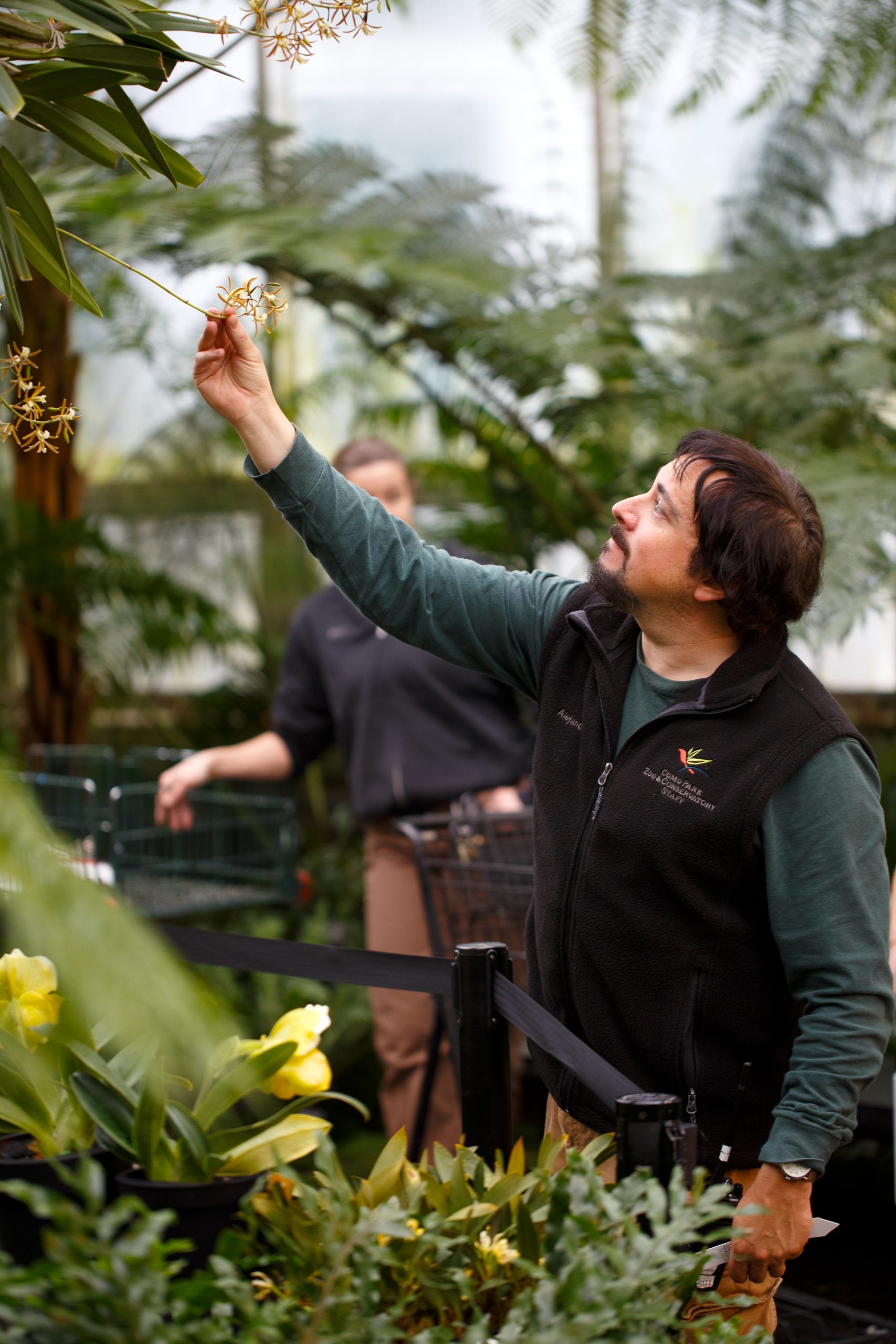
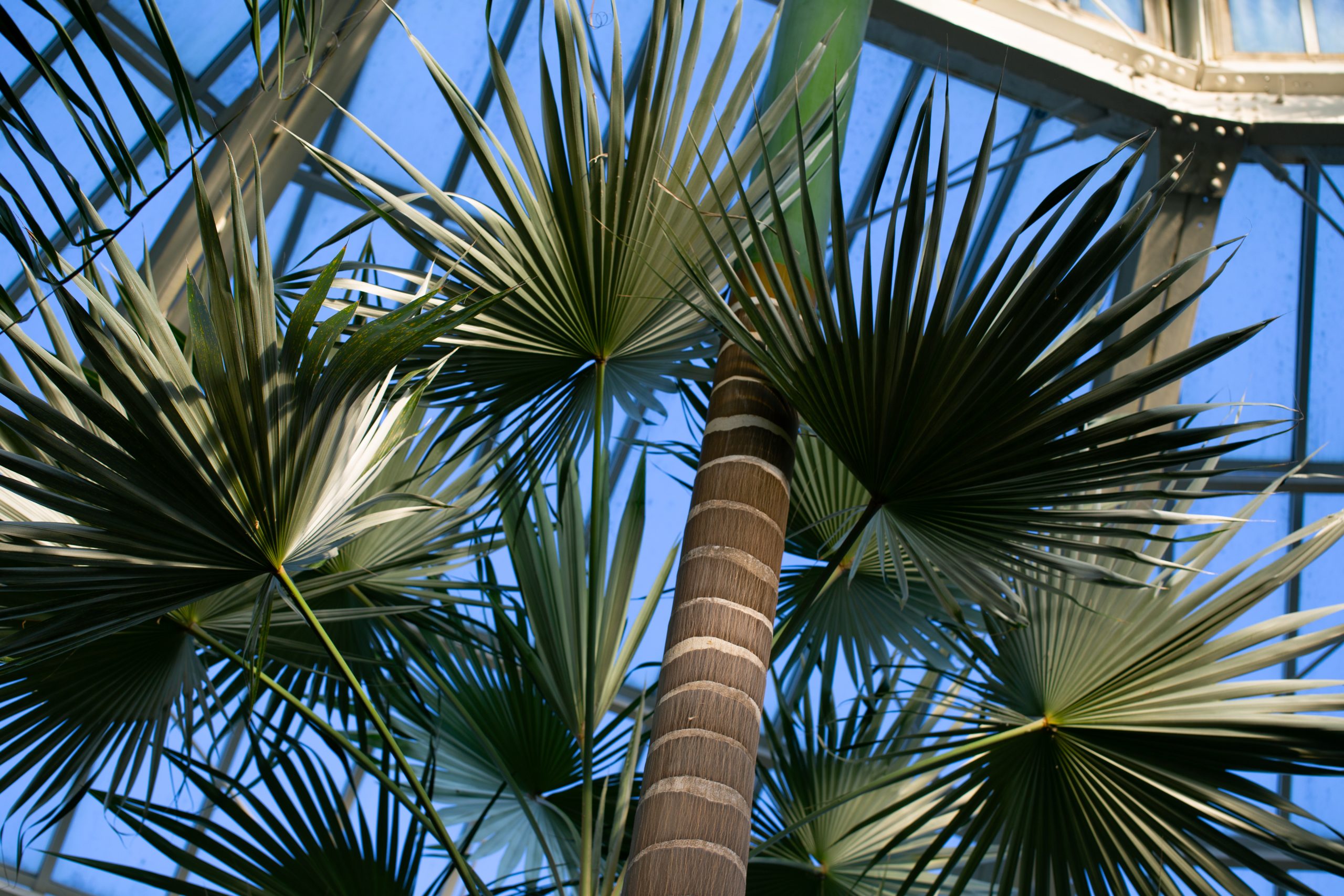
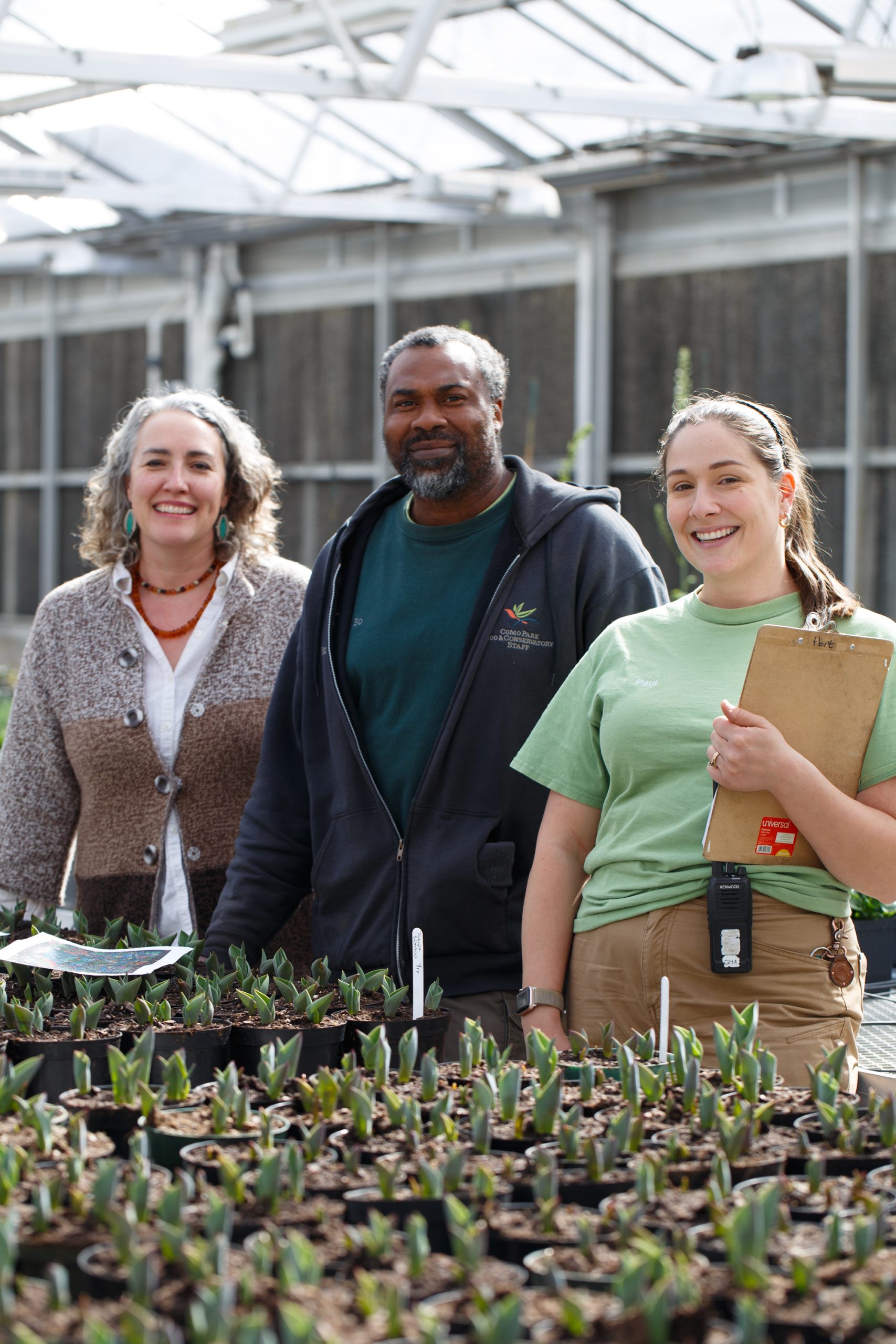
With more than 12,000 tulip, hyacinth, daffodil, crocus, and muscari bulbs grown especially for the Sunken Garden, The Marjorie McNeely Conservatory’s Spring Flower Show opening next week is always one of the Twin Cities’ most colorful rites of spring.
But this season, the plant list in “Minnesota’s most beautiful room” is also taking its cues from Minnesota’s springtime color palette. “Our goal is to make it look a little bit more like a forest,” says Como’s horticultural curator Dr. Lisa Philander.

For the show, Philander and horticulturists Bo Akinkuotu and Katie Horvath are introducing plant material that reflects Minnesota’s boreal forests and prairies. Visitors will notice birch logs and larger trees, milkweed, catchflies and black-eyed Susans, black pansies, columbine, snap dragons and delphinium, and even mini bogs that mimic the look of Minnesota’s wetlands. The show will also feature skunk cabbage provided by the Eloise Butler Wildflower Garden, and the showy lady’s slipper orchid, a recent gift from the Minnesota Landscape Arboretum.
Thanks to your contributions to Como Friends, all of the Marjorie McNeely Conservatory’s rotating flower shows are free to the public. The Spring Flower Show runs daily from March 22 to April 28.




The St. Paul Winter Carnival Orchid Show is the cure for the mid-winter blahs

With more than 28,000 naturally occurring species, the Orchidaceae family is one of the largest and most diverse of the world’s flowering plants. On January 27 and 28, Marjorie McNeely Conservatory visitors will get a chance to see the cream of the crop at the St. Paul Winter Carnival Orchid Show, a Como tradition for nearly 50 years.
Curating and designing Como’s display this year is horticulturist Alejandro Balderas, who cares about orchids even in his off-hours. “Before I moved to Minnesota from California, I had about 70 plants and 30 cultivars of my own,” he says. While he’s trimmed his personal collection to a more manageable size, there’s a good chance it will grow again once he’s had a look at the newest species and varietals for purchase at the Orchid Show’s marketplace. “There are so many shapes and sizes, and there’s always something new on the market,” he says. “It makes it hard to resist.”
Like the tulip mania that hit Europe in the 1600s, orchids had a similar history in the 1800s, when so-called “orchidelirium” sent prices for rare tropical species soaring into the stratosphere. But now with so many hearty varieties widely available in garden shops and grocery stores, orchids are no longer quite as intimidating to curious home gardeners.

“Orchid growing has become much more transparent because of the internet and with people having access to the literature online,” he says, from groups like the Orchid Society of Minnesota, a co-sponsor of the Winter Carnival Show. “They’re one of the few houseplants that actually flowers consistently,” he says, with colors made to attract pollinators and people stuck indoors during the winter. “Minnesotans seem to really love their orchids,” he says.
For the show, Balderas and other horticulturists are planning to display more than two dozen of the Marjorie McNeely Conservatory’s best species, drawn from a large working collection predominantly featuring plants from Central and South America. Set in the Fern Room, the design will feature a sculpture dedicated to the Conservatory on its 50th anniversary in 1965.
Advanced admission reservations are required to attend the St. Paul Winter Carnival Orchid Show, and tickets are $5 for adults and $4 for Como Friends members, seniors, and children under the age of 12. Visit this link for more information.

Your support for Como Friends helps to make the Conservation Champions program possible, supporting Como’s talented staff’s participation in conservation partnerships and in their continued professional development. Thank you!
Reusing, reducing and recycling is one of the secrets of Como’s Sunken Garden
Horticulturist Rylee Werden has fond memories of visiting Como with her mother and grandmother. “We always came to see the flowers together, so having the chance to design a flower show that connects with the Winter Carnival Orchid Show is really an honor.”

This season’s Winter Flower Show is a storybook example of an English-style cottage garden, with dense green foliage, deep pink and purple flowers, and a casually unkempt style—as if the garden is bursting out to fill its stone boundaries after years and years of growth.
“I was really inspired by the plant loropetalum which has a really nice weeping tree form and pretty flowers that I thought would make the pond look sort of enchanted,” says horticulturist Rylee Werden, who designed the show, her first for the Marjorie McNeely Conservatory. “From there I started building in more pinks and snowy whites and icy blues to play with the winter season. And the Winter Carnival Orchid Show coming later this month is what inspired me to use two of the flowers, a snapdragon called ‘Snappy Orchid Flame’, and a Viola called ‘Orchid Rose Beacon’”.

While most of the flowers you’ll see in this season’s show were grown from seed or plugs back in September, many supporting players in the Sunken Garden’s canopy were drafted from the Conservatory’s expansive greenhouse, design choices that are helping to make Como’s five seasonal flower shows more sustainable. For instance, the small birch trees featured in the Winter Flower Show were recently culled from the Charlotte Partridge Ordway Japanese Garden.
“Visitors seem to really love how they look, and we’re always excited to find a new use for what we already have,” says Werden. In fact, when the winter show is complete, the cuttings will be converted into birch poles for use in next year’s holiday plantings.
“As often as we can, we also try to give the plants and trees we use in the Sunken Garden a second life somewhere on campus, or in the community,” says Como’s horticultural curator, Dr. Lisa Philander. For years, spring bulbs pulled from the Sunken Garden have been recycled and resold through Como Friends’ Garden Safari Gifts, with proceeds that help pay for the next year’s bulb show. Your contributions to Como Friends are also helping the Marjorie McNeely Conservatory start a new on-site compost system with the capacity to turn tons of spent plant material into rich compost for future flower shows and gardens.
Making smart use of resources—from existing plant collections and from contributions from people like you—has helped Como Park Zoo & Conservatory keep its tradition of five rotating flower shows going for nearly 99 years. Thank you!
To sponsor the Marjorie McNeely Conservatory’s Sunken Garden visit:






